Sony Trying to Copyright Art Style of Spider Verse
Phil Lord and Christopher Miller, the creative producer team behind The Lego Motion picture and 21 Jump Street, take brought their unique sensibilities to a fresh and highly original version of Spider-Human, with the groundbreaking visual style of Spider-Human: Into the Spider-Verse, from Sony Pictures Animation.
The film'south genus lies in two key choices: firstly, the film makers did not hide away from the fact that there have been so many different tellings of the Spider-Man story previously, merely rather embraced it. Secondly, they designed an original comic volume visual style unlike whatever other film. Together these elements take been perfectly combined to produce a surprisingly original pic that delivers the most inventive visuals seen this year.
Led by the directors Bob Persichetti, Peter Ramsey and Rodney Rothman, the artists and visual effects team at Sony Pictures Imageworks (SPI) experimented with a dazzling visual style that pays homage to the wait of vintage comic-books. As director Peter Ramsey (Rise of the Guardians) explains, "Of course, dozens of Marvel movies lean on that look while telling a cinematic story, only I tin can't think of any other animated film that make this much of a visual statement. That's why audiences have had such a great reaction to the film."
Danny Dimian at SPI was the VFX supervisor. He saw the motion-picture show'south artistic journey as a natural evolution of what the studio has been able to achieve over the past two decades. "This return to Spider-Man reminds me of our work on The Hollow Man (2000)," says Dimian. "Like on Hollow Man, most of the technical challenges on this motion-picture show came out of creative challenges. This film was first and foremost rooted in coming up with something visually new. Through our early on tests, we quickly fell in dearest with the idea that there was something charming about the original comic books. That was the problem we prepare up for ourselves and we were really happy how nosotros concluded up with a look that was really cool and stylized, and yet we hadn't lost the feeling and the emotion in the characters."
The animation coiffure is the largest Sony Pictures Imageworks has ever had, due to the unique procedure to become to the correct look of the picture show. At that place were nine leads, with a majority of the squad in Vancouver and a smaller team of animators at the studio in Culver Metropolis.
Comic elements in the film include:
-
- Misregistration to imply defocus
- Graphic elements – used to fill the frame like "Blast" and "Pow"
- Panelization – breaks upwards activity into panels and the blitheness frame rate mimics jumping from 1 panel to the side by side
- One-half-tone dots – to render tone and texture
- Colors – cleaved downwards into defined shapes to requite them a more illustrative feel
- Hand-drawings – certain effects such equally fume, sparks, and explosions are hand-drawn past the artists
Defocus
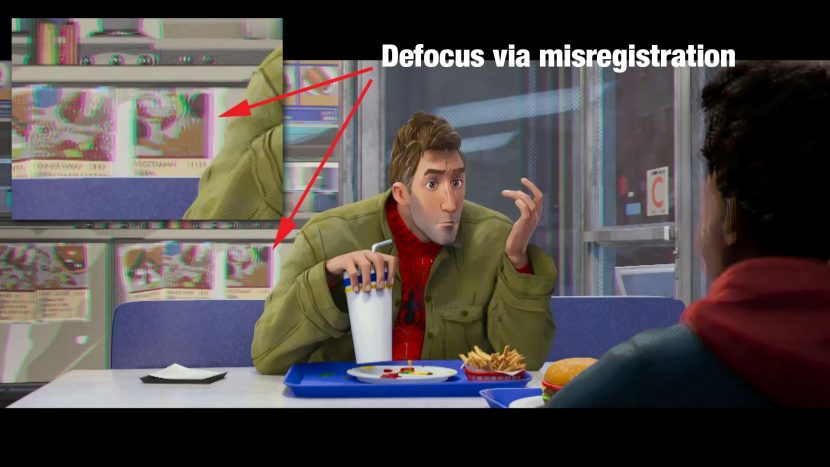
Among the many stylistic means the Imageworks team paid homage to old comic-books was emulating the imperfections of color offsets. "Nosotros noticed that sometimes in printing comic books, the colour offsets were not aligned properly and this looked like the epitome was out of focus," says Dimian. "We took that equally an opportunity to explore how to play with focusing the photographic camera based on the start printing techniques. We looked at lots of dissimilar types of comic books in analogy printing, and nosotros saw that it was hard to focus on an image when all the color passes were not properly aligned. We thought, 'What if the camera didn't de-focus like a lens?' So, we splintered and commencement the image in a fashion that is similar to a misprinted comic book page. It has a actually cool feel to it that creates this illusion that something is printed on the screen."
Motion Mistiness
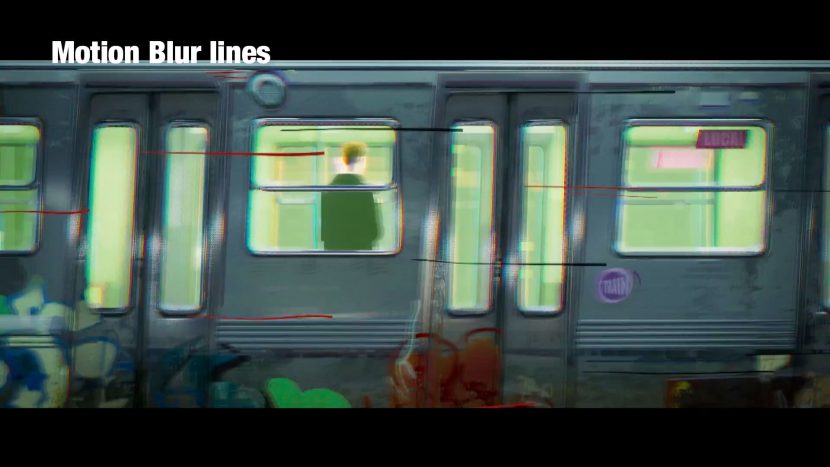
The filmmakers eliminated the idea of motion blurs for the film. The bulk of the animation is done in twos instead of ones (images are held for two frames, rather than one – or twelve images per second, instead of twenty-four images), which is rare for CG. In fact, the directors wanted each frame of the film to look like a painting when paused to stay true to the comic book style. For scenes such as this train shot, lines are placed over the railroad train and a rolling shutter upshot is introduced to imply move mistiness where at that place is none.
Dimian believes these graphical elements and overlaid lines in the shots were both an homage to the comic books and something that helped solve a problem. As the team had eliminated depth of field, they knew they would besides need to eliminate motion blur, but they needed a new arroyo that was similar, but dissimilar to the misregistration used to solve depth of field.
The team decided that they could never get the look of the animation right when information technology was too splined or too polish. This pb to the determination to utilize "step down blitheness to allow animation to hold poses for equally long as they needed. Sometimes it's two, sometimes it's on threes – that's actually snappy," Dimian comments.
There is no traditional motion blur where a camera shutter is open up for a certain amount of time and information technology thus blurs the paradigm in the motion-picture show. "This is yet another example of a creative problem, that turned into a technical problem. That creative option in turn rippled through the whole pipeline with a bunch of technical bug."
Comic book panels
At diverse times in the story the frame breaks into multiple comic book frames.
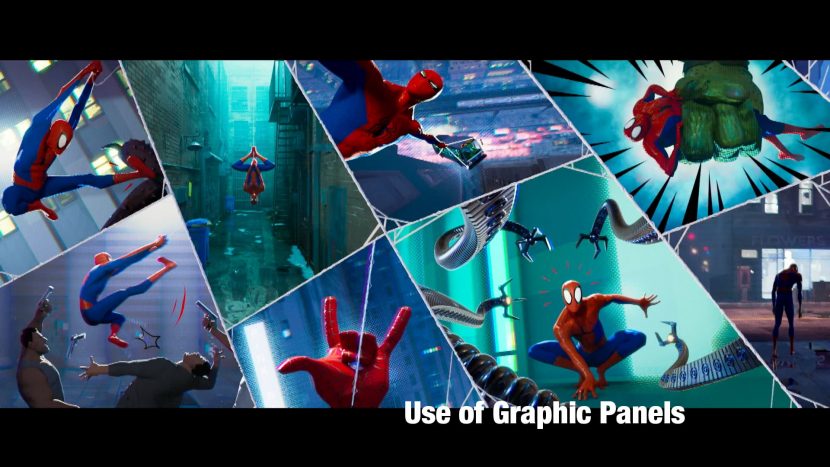
From a cinematography indicate of view, "that was a real headache, because you want animation to be completely aware of these panels and you want to do all the planning when you're in rough layout. " Dimian explained. The frame story ideas come out of the storyboards, "we had mock ups of the look right away in rough layout but animation could then change that timing. They could change how the panels worked so that the panels worked with their performance. Just, it is an extremely sophisticated thing, when yous think about the fact that the panels need to relate to each other." The activeness is each console has to piece of work separately and also as a whole, so multiple activity blitheness sequences need to exist choreographed to piece of work together. Added to this an animator could request that their panel piece shape or aspect ratio be modified to ameliorate tell that panels story and it is little wonder these shots were some of the most complex to approve. Dimian commented, "It'due south all a very unlike mode to tell stories. Our overall intention was to utilise multi panels, text within the screen, words like thoughts and even words to represent explosions. To employ an analogy, these are all kind of different and new ingredients and when we started to brand this film was that was the first fourth dimension we had e'er cooked with all these ingredients together at once."
The filmmakers also wanted a different look for the portal experience of the passageways to other universes. This was to stand for what would happen when the smashing of the subatomic particles created a tear in the space-time continuum. The technical team at SPI developed a camera array that allowed them to project seven different angles on the screen at the same time, while enabling them to return each one of those cameras in a dissimilar mode. Visually, the net effect looks not unlike abstruse or mod art.
Halftone and cross hatch printing.
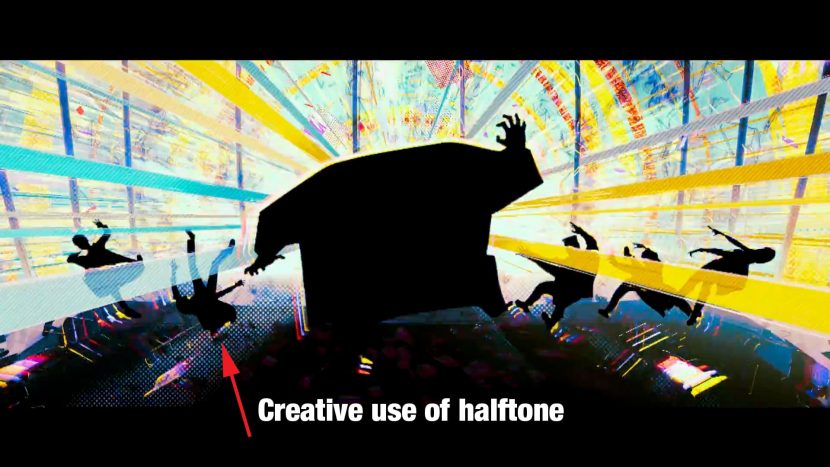
The picture uses an incredible digital version of 4-color press from older comic books and a mixture of cross hatch inking and half-tone dots to add together texture and visual interest.
The effects team was given the dark-green light to experiment with new technology that led to the invention of the pic's "glitching" effect. The glitch happens on characters, buildings, and cars when dimensional earthquakes occur equally a upshot of the arrivals of characters from alternative Spider-Verses. They used multiple cameras that mirrored the multiple universes – they are all shot on the same character and same animation, but are treated differently, creating a cubist, fragmented look.
Lines of Action
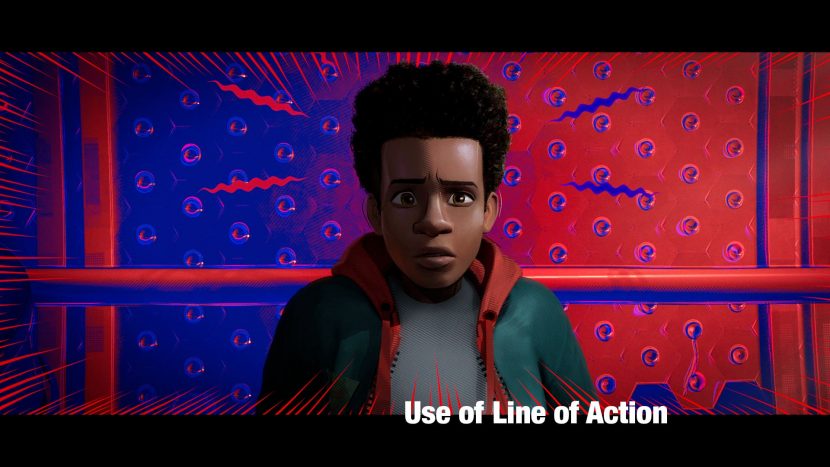
"Computers do everything correctly and and then you always have the right perspective and geometry all the time," Dimian points out. "What's interesting and expressive about art is all the imperfections that become manus in hand with a man creating things. We had to find a manner to break things and allow the hand of the artist to evidence through. Design and emotion took priority over accuracy and realism."
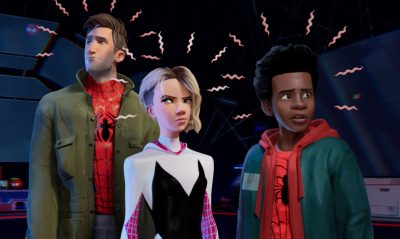 While working on the picture show, Dimian constantly referred back to a quote from a scientist that says, "Success is going from failure to failure with undiminished enthusiasm." The creative team was encouraged to endeavour new things that oasis't been done before, even if it meant failing, in guild to find ways to reach their finish goal of creating a unique final look to the picture show.
While working on the picture show, Dimian constantly referred back to a quote from a scientist that says, "Success is going from failure to failure with undiminished enthusiasm." The creative team was encouraged to endeavour new things that oasis't been done before, even if it meant failing, in guild to find ways to reach their finish goal of creating a unique final look to the picture show.
Special Modelling consideration
It is non uncommon for a graphic novelist or comic book artist to exaggerate a perspective, but in 3D this takes on a whole new level of complexity – not just one of lensing simply also distorting the actual geometry. This was done heavily in the picture, especially in the surround work of the city.
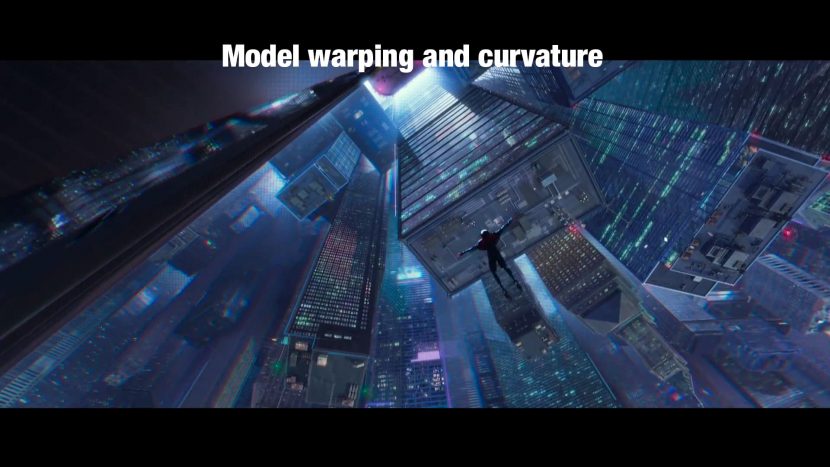
In the motion-picture show when Miles leaps off the building and falls back into the city, "you see that very clearly beingness used for dramatic consequence. All the buildings in New York are actually oriented in kind of a ring effectually him. Of course that's non real. That's not the way most of our buildings were arranged in New York, merely it but didn't have the aforementioned drama to have Miles leap off into a grid of buildings," explains Dimian. "And then he falls off into a sort of circular blueprint and even and so it did non give the feeling that we wanted, and then those buildings are not perpendicular to the ground. They are severely leaning and their heights tin vary from similar five times to eight times the height that the New York set actually was…only these are just things just visually looked cool."
Integration of Different Animation Styles.
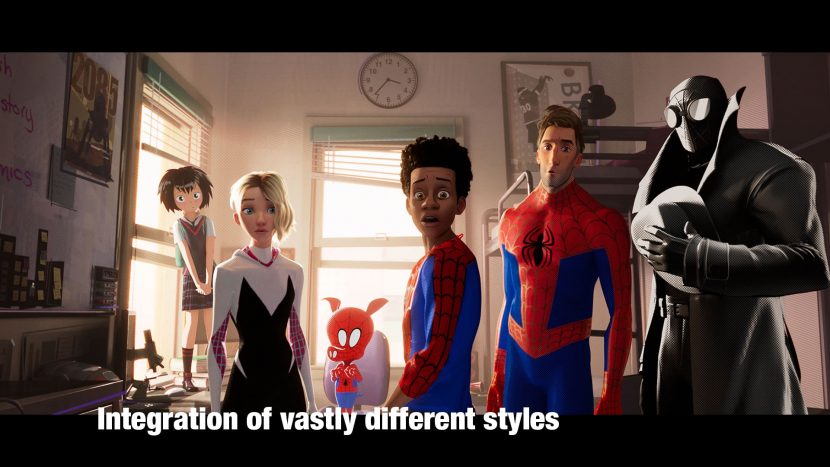
One of the film'southward remarkable achievements is providing so many completely unlike characters on screen in such dissimilar styles and yet making them experience as if they are in the same physical space lit past the same light sources.
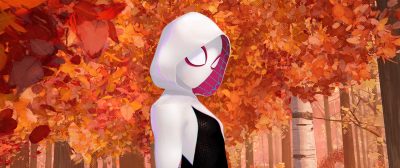
From a black and white only Spider-Human Noir to an anthropomorphic Looney Tunes style graphic symbol called Peter Porker/Spider-Ham, the film encompasses an incredibly diverse range of animation and visual styles.
In addition to the usual powers such as web shooting, sticking to objects, speed, forcefulness, incredible hearing and Spidey sense, Spider-Gwen uses graceful ballet-type movements in her fighting, which provided yet some other stylistic addition to the mix.
Peni Parker is another one of the Spider-Verse'southward unexpected delights. This anime Spidey heroine hails from a future version of Earth, in a robot adapt. Lone, any one of these characters would present unique challenges but they often needed to work on screen together in the same shot, something that must accept seen almost unattainable in pre-production.
While animators normally create approximately 4 seconds of animation per week, on Spider-Man: Into the Spider-Poetry the pipeline was so circuitous and groundbreaking that they were only able to produce on average ane second of animation per week. This led to hiring more animators to have on the workload and achieve the unique visual mode. In the end, artists from over 30 dissimilar countries contributed to the work on the motion-picture show, integrating dissimilar styles.
Faces and Rigs
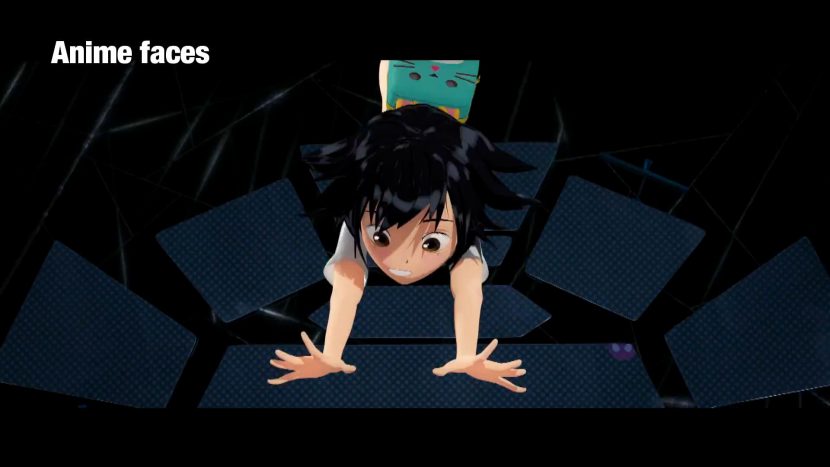
For the most role the character rigs were not that different from previous rigs and blend-shape models the team were used to. The company has had a lot of feel with extreme poses and characters from their films such as Cloudy with a Risk of Meatballs and the HotelTransylvania films, "so for the hero characters, they had a lot in common with those previous rigs. Peni was the big exception."
To achieve the anime expect, the animators animated the digital model merely then her face was effectively removed and replaced as a 'decal'. "In that location is no formal facial geometry for Peni. Her looks are from animation, but they are converted to a decal that is perfectly apartment, and shaded apartment. So we could make her as 'Anime flat' as we wanted. And that was that was important to the spirit of the world she comes from," Dimian comments.
Archetype Comic Volume Tools
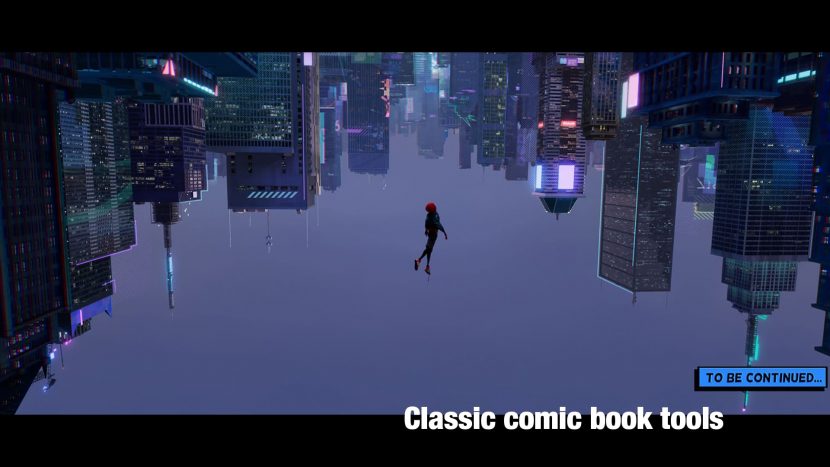
The flick uses many devices and tools lifted direct from printed comic books – nigh noticeably, the direct use of text on screen as exposition and audience direction. These text boxes are overlaid or move as part of the camera movement.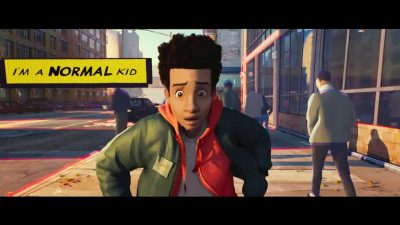
As art director Dean Gordon, who also worked on the two Cloudy movies with Lord and Miller, explains, "The nature of technology of CG tends to fight a graphic look. We made hand-painted textures, with a level of brainchild to them, that nosotros mapped onto geometry to get a more than illustrative feel to our globe. We did not desire photorealism. We broke down gradations and color values into areas and created shorter transitions between them to get a more illustrative feel in the scenes. We brought the same ideas for the characters' skin tones. Having the skin tones fit in the same environment and use the same screentones and hatchings we see in comics elevated that comic volume look."
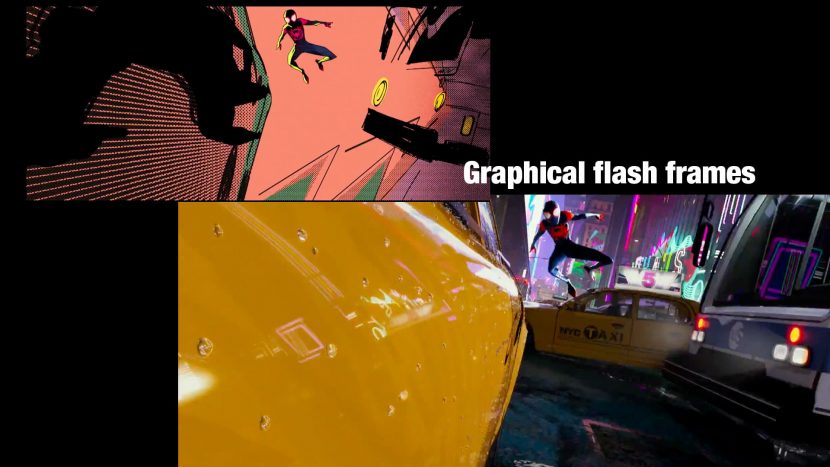
The squad at SPI set out to recreate the tactile, granular feeling of a graphic novels, even going equally far as recreating the literal graphic wink frames in sequences right out of the older comic-books in terms of manner. "You really experience the artistry every bit yous turned the page," recalls product designer Justin K. Thompson. "I know that 1 thing the computer does actually well is realism. What nosotros wanted to practice was to invent our own reality, and then curve all the rules…I learned how to draw by emulating the art work I loved in comics, and Spider-Man was a graphic symbol that I loved from an early age. That's why I was actually excited when Chris and Phil told me, 'What if y'all were given menu blanche and could make an animated movie based on a comic-volume?'"
Comic Book Sound FX.
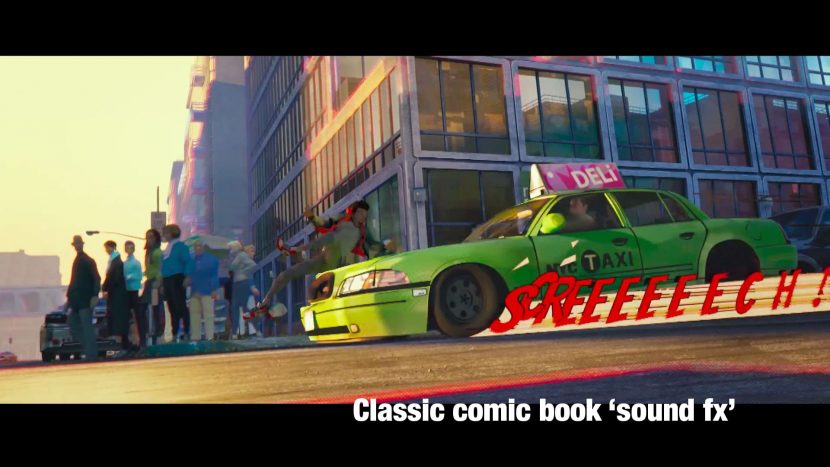
In addition to moving to a more painterly manner to betoken focus and depth, this frame adds actual former school text on screen to underscore the sound furnishings.
While the sound was done post-blitheness, the team was very aware of designing for sound and allowing the audio effects team screen fourth dimension to score the action.
montgomeryfescithavers.blogspot.com
Source: https://www.fxguide.com/fxfeatured/why-spider-verse-has-the-most-inventive-visuals-youll-see-this-year/
0 Response to "Sony Trying to Copyright Art Style of Spider Verse"
Post a Comment